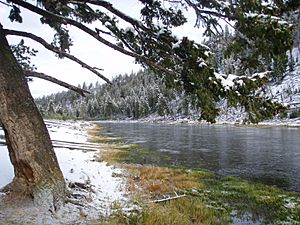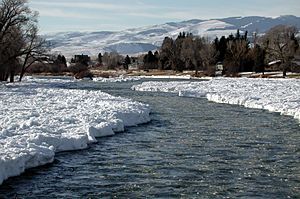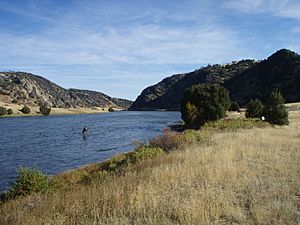Madison River facts for kids
Quick facts for kids Madison River |
|
|---|---|
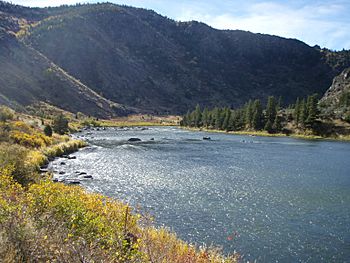
Lower Madison River In Bear Trap Canyon Below Ennis, Montana
|
|
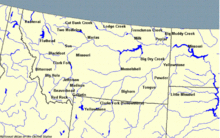
Montana rivers. The Madison is in the southwest corner.
|
|
| Country | United States |
| State | Wyoming, Montana |
| Physical characteristics | |
| Main source | Madison Junction Yellowstone National Park, Wyoming 44°38′32″N 110°51′56″W / 44.64222°N 110.86556°W |
| River mouth | Missouri River Three Forks, Montana 45°55′39″N 111°30′29″W / 45.92750°N 111.50806°W |
| Length | 183 mi (295 km) |
| Basin features | |
| Tributaries |
|
The Madison River is a cool river in Wyoming and Montana. It's about 183 miles (295 km) long. The Madison is a "headwater tributary" of the Missouri River. This means it's one of the main streams that come together to form the Missouri River.
The Madison River starts in Yellowstone National Park. It begins where two other rivers, the Firehole and the Gibbon, meet at a spot called Madison Junction. From there, it flows through mountains in southwestern Montana. Finally, it joins the Jefferson and Gallatin rivers near a town called Three Forks. When these three rivers meet, they officially form the mighty Missouri River! You can visit Missouri Headwaters State Park at Three Forks to see this special spot.
Along its journey, the Madison River helps create two lakes. The Hebgen Dam forms Hebgen Lake in its upper part. Further downstream, the Madison Dam creates Ennis Lake. This dam also helps make electricity for people to use. In 1959, a big earthquake happened near Hebgen Dam. This earthquake created a new lake called Quake Lake just below the dam. The Madison River also flows through a wild area called Bear Trap Canyon. This part of the river has exciting whitewater rapids, some of the toughest around!
Contents
Naming the Madison River
The Madison River got its name in July 1805. Meriwether Lewis, a famous explorer, named it at Three Forks. He named this central fork of the three rivers after James Madison. At the time, Madison was the United States Secretary of State. He later became the fourth President. The western fork was named for President Thomas Jefferson. The eastern fork was named for Albert Gallatin, who was the United States Secretary of the Treasury.
Fishing in the Madison River
The Madison River is super famous for fly fishing. Many serious anglers, or people who love to fish, come here. It's known as a "blue ribbon fishery" in Montana. This means it's one of the best places to catch fish. The river is full of brown trout, rainbow trout, and mountain whitefish.
For fishing, the Madison River can be split into four main parts.
Madison River in Yellowstone National Park
The Madison River flows for about 19 miles (31 km) inside Yellowstone National Park. This part of the river is not easy for beginners. It's great for experienced anglers who like a challenge. You can catch rainbow and brown trout here. Most of these fish are 10 to 14 inches long, but sometimes you might catch a 20-inch one! This part of the river is often called the "world's largest chalkstream." This means it's like a special type of river with clear, calm water.
Fishing is best here in early summer and fall. In mid-summer, the water can get too warm. In the fall, many big brown and rainbow trout swim into the river from Hebgen Lake. Anglers often use large "streamer patterns" to catch them. Many spots on the river have fun names like The Barns or Baker's Hole. Inside Yellowstone National Park, you can only fish with a fly, and all fish must be released back into the water.
Yellowstone Park Boundary to Quake Lake
After leaving Yellowstone Park, the Madison River flows through beautiful ranch lands. Here, it truly shows why it's a world-class fishing spot. The river winds through areas with cottonwood trees. It has calm spots and faster sections where big rainbow and trophy brown trout live. The Madison River flows along the West Entrance road of Yellowstone. In 1959, the Hebgen Lake earthquake created Quake Lake just below Hebgen Dam.
Upper Madison: Quake Lake to Ennis Lake
Right below Quake Lake, there's a three-mile (5 km) section of wild whitewater. This part was created by the 1959 earthquake. It has a steep slope and huge boulders, making it very challenging for boats.
After this whitewater section, the river becomes calmer for about 53 miles (85 km) until it reaches Ennis Lake. This part is often called the "Fifty Mile Riffle." It's known as the best place for fly fishing on the river. There are a few small fishing shops along this section. The main town nearby is Ennis, which is close to Ennis Lake. Because of all the great trout, Ennis is sometimes called "Trout Town, USA." In some parts of the Upper Madison, you can only fish while standing in the water (wade fishing). Boats can float through, but you can't fish from them.
Lower Madison: Ennis Lake to Three Forks
This part of the Madison River starts with a short section below Ennis Dam. This area is great for wade fishing. After a power station, the river gets bigger and flows into Bear Trap Canyon for about 7 miles. It's a wild area, so you can only reach the river by hiking trails. If you're willing to hike, you can find quiet spots to fish. Floating through the canyon is possible, but it has some tough whitewater.
After the canyon, the river flows in shallow, fast-moving sections until it reaches Three Forks. Here, it joins the other rivers to form the Missouri. This section is easy to float and has good spots to wade fish.
The Lower Madison is good for fishing in spring, fall, and winter. In summer, the water can get too warm, which isn't good for fish that are caught and released. Winter fishing, especially in Bear Trap Canyon, is popular with locals. They often catch fish when small insects called midges are hatching.
River Advocates
Many groups work hard to protect the Madison River and its environment:
- Trout Unlimited — This group works to protect and restore coldwater fisheries and their rivers across North America.
- Western Watersheds Project — Their goal is to protect and restore western rivers and wildlife through education and public action.
- Montana River Action — This group works to protect and restore Montana's rivers and streams. They believe clean water is a right for everyone.
- Madison River Foundation — This group focuses on protecting and improving the Madison River and the land around it.
See also
In Spanish: Río Madison para niños


